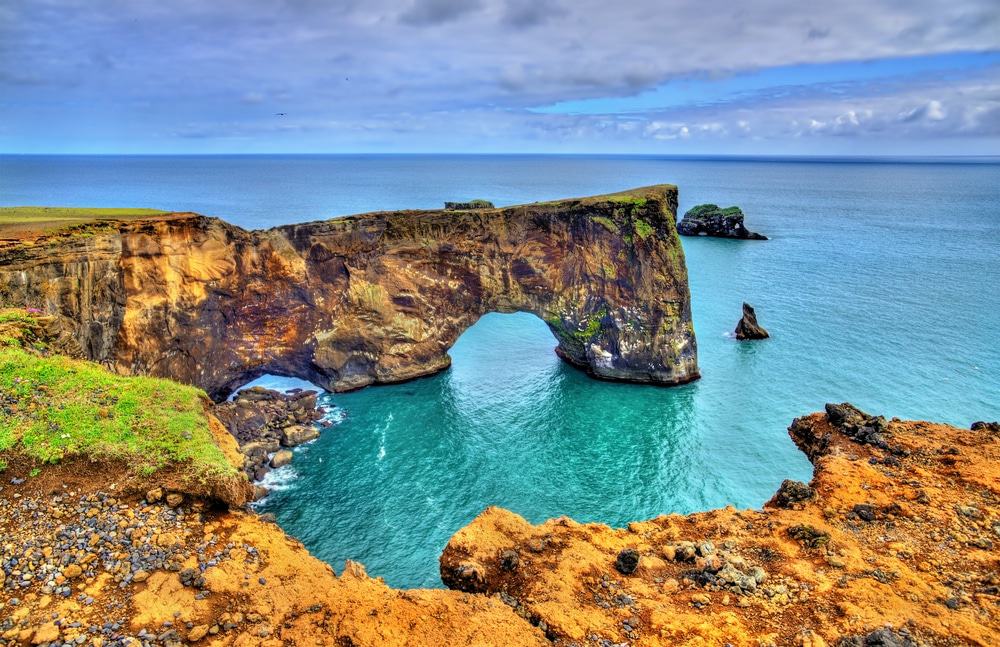Summary
You have undoubtedly encountered information regarding Iceland’s glaciers, volcanoes, and geothermal springs. In the South Iceland region, you have the opportunity to experience them firsthand.
The most accessible means to explore the region is by traversing the Golden Circle, featuring the site of Europe’s oldest parliament, the majestic Gullfoss waterfall, and the famed geyser that inspired all others, all within a single itinerary.
For a more profound exploration, one can traverse a glacier utilizing an ice axe, stroll along a beach of striking black sands, immerse oneself in a geothermal river, and marvel at an array of breathtaking waterfalls, each evoking a sense of wonder.
The region exudes a powerful sense of spectacle and enchantment, which explains the rich romantic narratives surrounding each canyon, waterfall, and volcano, deeply rooted in the mythology and folklore from the Settlement period.
Let us delve into the best activities in South Iceland:
1. Þingvellir

Þingvellir is both a National Park and a UNESCO World Heritage Site, possessing genuine historical and cultural significance that complements its geological relevance.
This site served as the venue for the Althing, the oldest parliament in Europe, convened since 930 and continuing until 1798. Chieftains from the eastern regions of Iceland would often undertake journeys lasting up to 17 days to reach this location.
Þingvellir is also situated on the Mid-Atlantic Ridge, the boundary between the North American and Eurasian tectonic plates. While driving from Reykjavik, one will experience this transition by descending a sheer cliff from North America to Eurasia.
At the location where the rocky boundary has collapsed, you will find the Almannagjá gorge, which provides hiking opportunities between the plates that are separating at a rate of two centimeters annually.
2. Gullfoss

The wide Hvítá (White River) cascades 32 meters at this breathtaking double waterfall.
The Gullfoss falls display striking drama, as the splash pool in the crevasse remains concealed when approached along the path, creating the illusion that the river flows into an infinite void.
Above the two drops of the waterfall (11 meters and 21 meters) lies a cascade comprised of three steps, with the volume of water flowing over the falls varying considerably with the seasons.
During summer, the falls collect rainwater and glacial runoff, resulting in a discharge rate of 140 cubic meters per second.
In winter, visitors frequently stop by to photograph the northern lights illuminating the falls.
3. Geysir

The final member of the trio of extraordinary natural attractions along the Golden Circle is the original geyser, Geysir.
This powerful spring has been ejecting boiling water up to 70 meters into the atmosphere for over 10,000 years.
Currently, Geysir is experiencing one of its quiet phases, but in the 17th century, its eruptions were so powerful they would cause the ground to tremble.
Nevertheless, despite Geysir’s current inactivity, visitors will not be disappointed as Strokkur ejects water to a height of 15 meters and is one of approximately 30 geysers and vibrant hot pools in the vicinity.
A gift shop and café are available at the park, with an admission fee of ISK 600 noted in 2018.
4. Reynisfjara Beach

As far as rugged Atlantic beaches are concerned, Reynisfjara possesses an exceptional character.
The sand is deep black, transitioning into rounded pebbles as one approaches the unique basalt columns behind, resembling the pipes of a colossal organ.
Majestic basalt stacks rise out of the sea.
Folklore suggests these are two trolls who attempted to drag a three-masted ship to shore, turning into massive needles stranded in the water when sunlight broke.
Reynisfjara Beach demands respect and is notorious for its sneaker waves, which can unexpectedly wash ashore and catch visitors off guard.
It is prudent to proceed with caution and always remain facing the ocean.
5. Skógafoss

As captivating as any of the attractions on this list, Skógafoss is a 60-meter-high waterfall on the Skógá River, surrounded by lush cliffs.
If you are able to choose a day for your visit to Skógafoss, aim for a sunny day when the falls’ spray creates a radiant rainbow.
Interestingly, these cliffs were once coastal and have since shifted inland by five kilometers due to tectonic activity.
A legend exists that the first Viking settler in the area, Þrasi Þórólfsson, concealed a treasure chest within the cave behind the waterfall.
When locals discovered the chest, they could only grasp the ring, which detached and was subsequently used as the handle for the church door.
You may utilize Skógafoss as the initial stop on a trekking route along the Skógá, where you will encounter a series of spectacular waterfalls such as Brúarfoss and Miðfoss, located just a few hundred meters apart.
6. Skogasafn
Open from June to August, Skogasafn is an outdoor museum showcasing life and work in Iceland during the 20th century.
The site consists of 13 structures, many featuring traditional Icelandic turf roofs, and each is filled with antique furniture, fishing and farming tools, traditional costumes, cooking implements, and handicrafts.
Artifacts from the Viking Age are also exhibited, including the original ring from the church door.
The significance of furs in Iceland’s history is highlighted, alongside a classroom from the early 20th century, equipped with a vintage organ.
Additionally, an exhibition chronicles advancements in technology and transportation during the 19th and 20th centuries, featuring a postal van from the 1910s and an amphibious rescue vehicle.
7. Kerið

Located on the Golden Circle, Kerið is a volcanic basin lake featuring striking milky teal waters in stark contrast to the dark red and black slopes of the crater.
This depression was long thought to be a crater from a 3,000-year-old explosion; however, recent studies indicate it is a collapsed magma chamber resulting from an eruption 6,000 years ago.
Kerið reaches a depth of 55 meters, including its water pool, which is perched at the same level as the underground water table and is not influenced by rainfall.
8. Urriðafoss

The Þjórsá, Iceland’s longest river at 230 kilometers, also possesses the second largest volume.
At Urriðafoss, located on the edge of the Þjórsárhraun lava field, the river cascades over a six-meter drop.
What is astonishing about these falls is that salmon manage to travel upstream.
It has been suggested that these fish possess unusually long tailbones enabling them to succeed in navigating Urriðafoss.
The Þjórsárhraun lava field nearby is the product of the largest lava flow on the planet since the Ice Age.
9. Vík í Mýrdal

Situated at the southernmost point of Iceland, Vík boasts a somewhat precarious position between the North Atlantic and the active Katla glacier-volcano.
The Katla last erupted in 1918, and another eruption is imminent, which could severely impact the village.
The locale is idyllic, nestled in the beautiful Mýrdal valley, nourished by glacial rivers descending from Katla and another prominent glacier, Mýrdalsjökull.
During the summer, visitors can fish for trout in Lake Heiðarvatn, explore the terrain in an amphibious vehicle, and embark on hikes through the verdant pastures.
A campsite in the area features a kitchen with a fireplace inside a natural cave.
The greenery of the valley juxtaposed with the dark pillars of the Reynisdrangar sea stacks provides a stunning backdrop for photographers.
10. Fjaðrárgljúfur

Forged by the runoff from a glacial lake at the conclusion of the last Ice Age approximately 9,000 years ago, Fjaðrárgljúfur is an impressive canyon, reaching depths of 100 meters and stretching nearly two kilometers in length.
The gorge is narrow and winding, flanked by steep walls.
The ground beneath your feet consists of two-million-year-old palagonite, formed through the interaction of water with volcanic glass.
Adventurous hikers may opt to journey along the canyon floor, occasionally wading through water and reaching the base of a waterfall.
Alternatively, one may choose to remain along the rim of the canyon, peering down into the depths at intervals.
11. Laugavegur

Revered as one of the world’s finest hiking trails, the 55-kilometer Laugavegur begins at the Landmannalaugar hot springs and culminates two to four days later at the Þórsmörk nature reserve.
The appeal of this trail lies in the diverse natural features encountered along the way.
Hikers will traverse landscapes including black scree deserts, geothermal springs, lush valleys, volcanic peaks, and views of glaciers.
The optimal time for this journey is from June to August, with accommodations available in huts and campsites along the route.
Even in the most remote locations, scheduled daily buses operate between both ends of the trail and Reykjavik.
12. Dyrhólaey

This peninsula, or promontory depending on how you define it, rises 120 meters above the crashing waves below, topped by a solitary lighthouse resembling a castle.
Situated close to Vík í Mýrdal, Dyrhólaey is a birdwatcher’s paradise, especially during the summer months when puffins nest in the crevices of the cliffs.
There are restrictions in place to protect the nesting sites during this season, thus it is advisable to conduct research before embarking on your visit.
Natural arches have formed from the dark lava of Dyrhólaey.
Looking east, one can spot the imposing Reynisdrangar stacks, while to the west, the dark seascape illustrates where the Selfoss river meets the ocean.
13. Sólheimajökull

Located just north of Vík í Mýrdal and part of the Mýrdalsjökull ice cap, Sólheimajökull is a glacial tongue characterized by crevasses, sinkholes, and ridges, representing a landscape in constant flux.
Exploring the glacier requires utilizing an ice axe and crampons while on a guided trek with an expert, who can ensure safety and provide insight into its structure and history.
In certain areas, you can observe stratified cross-sections of ice, several hundreds of years old, showcasing mesmerizing blue hues.
From the summit, you can gaze as far as Eyjafjallajökull, which gained international attention due to its eruption in 2010.
14. Reykjadalur Valley
Located thirty minutes outside of Reykjavík is another lush valley filled with bubbling mud pools and steaming fumaroles.
True to its name, “Reykjadalur” translates to “Steam Valley,” and from the parking area, you commence a three-kilometer hiking trail to reach this destination.
In quintessential Icelandic fashion, the valley exhibits stunning diversity, showcasing cascades, vibrant hues of sulfur, wildflowers, and mysterious steam plumes drifting about.
The trail serves as a popular route for treks on beautiful Icelandic horses.
Ultimately, you will arrive at a segment of river lined with wooden boardwalks where you can safely bathe.
This river is sourced from hot springs situated high in the valley, guaranteeing a rise in water temperature the further up you venture.
15. Fimmvörðuháls Hiking Trail
The “Five Cairns Pass,” as it translates, spans from Skógá near the coast to Þórsmörk, traversing the Fimmvörðuháls pass nestled between the Eyjafjallajökull and Mýrdalsjökull glaciers.
The route extends 22 kilometers and involves a vertical elevation gain of just over 1,000 meters.
Initially closed following the volcanic eruption beneath Eyjafjallajökull, the trail was quickly reopened, albeit framed by notably different scenery than before.
For those desiring an expansive volcanic adventure, the Fimmvörðuháls Hiking Trail may be combined with the earlier discussed Laugavegur trail.





